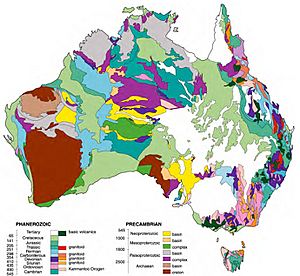Geology of Australia facts for kids
The geology of Australia tells a story over 3.8 billion years old. Australia is a huge landmass, or continent, sitting on the Indo-Australian Plate. It is incredibly ancient and has many different kinds of rocks.
Long ago, Australia was part of a giant supercontinent called Gondwana. This huge landmass included places like New Guinea, Antarctica, Africa, and South America. Australia and New Guinea are still on the same tectonic plate.
During times when sea levels were low, Australia and New Guinea were connected by land. This larger area is sometimes called Greater Australia. After the last Ice age, sea levels rose. This caused the area now known as the Torres Strait to flood, separating Australia and New Guinea.
Ancient Rocks and Landmasses
Australia's land is made up of several very old and strong blocks of rock. These are like the foundations of the continent.
- The Yilgarn Craton is one of these ancient blocks. It formed billions of years ago. It even has the oldest known meteorite impact crater, called the Yarrabubba crater. This crater is about 2.229 billion years old!
- The Pilbara Craton is another very old block.
- The Gawler Craton and Willyama Block are also ancient parts of the continent.
Around these old blocks, you can find belts of volcanic rocks and areas where sedimentary rocks have built up. These blocks came together to form the larger Australian landmass a very long time ago.
The western part of Australia is much thicker than the eastern part. The continent's crust is mostly made of very old granite and gneiss rocks. A thinner layer of younger sedimentary rocks covers much of Australia. These layers can be up to 7 kilometers thick!
Meteorite Craters
Australia has many places where meteorites have crashed into the Earth. Scientists have confirmed 27 impact craters across the continent.
- The Gosses Bluff crater (also called Tnorala) is in the southern Northern Territory. It is about 22 kilometers wide and formed about 142.5 million years ago.
- The Shoemaker crater in central Western Australia is even bigger, more than 30 kilometers wide. It was formed about 1.63 billion years ago.
- The Wolf Creek crater in Western Australia is smaller, about 875 meters wide. It formed more recently, around 150,000 years ago.
The Yarrabubba crater in Western Australia is the oldest known impact structure on Earth. It is estimated to be 2.229 billion years old.
Images for kids



